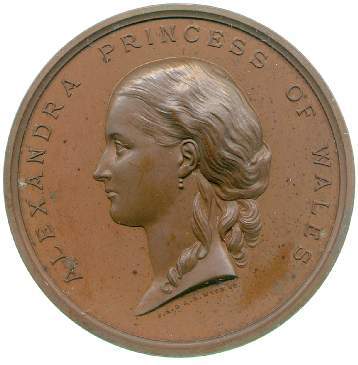Current Location: In storage
Maker(s)
Artist:
Wyon, Joseph Shepherd
Issuer:
Farningham Homes for Little Boys
Die-engraver:
Wyon, Alfred Benjamin
Entities
Categories
Description
The Farningham Homes for Little Boys were a philanthropic endeavour of the Victorian era, being eventually 11 separate houses and a school, chapel and workshops, built on the hill above South Darenth in Farningham from 1867 onwards. The foundation stone was laid by Princess Alexandra. The Homes were intended to "feed, clothe, educate and train to industrial work, homeless and destitute little boys", unlike existing children's homes which accepted only orphans rather than the actually homeless. Functioning as a kind of apprentices' college, the Homes turned out, as well as many hundreds of pupils, several manufactures that still adorn the corridors of royalty. The Homes, under state operation after 1952 but increasingly criticised for the standards of education that the establishment was able to provide, were finally closed in 1961; the concomitant memorial service more than filled the chapel. The site was sold to Kent County Council in 1962 and the North Downs Approved School built there. Thereafter a branch of the National Children's Home was opened from the Homes' funds at Elmstead Woods in 1966, under the name Farningham House, and through this institution the trust's original aims are continued.
The first President of the Homes for Little Boys was Robert Culling Hanbury, MP for Middlesex, who died in 1867. At his death a Memorial Fund was established, and it was agreed to establish the Hanbury Memorial Prizes therefrom. These were to be awarded, "to each boy who has left the Home and kept his situation a full year, or longer, and who returns on Old Boys' Day, within five full years of his leaving the Home, having previously sent to the Secretary a written testimonial from his mastere, stating that he has behaved properly and is industrious"; after the award, if the boy returned each year for four years more, he could expect an increasing money prize and eventual inscription on the Homes' Roll of Honour. The Prize could also be awarded to apprentices in the Homes who could obtain similar testimonials from their trademasters and housemasters.
The first award of the Prize was made in 1868, to Joseph Geoghagan; the last entries in the Homes' Prize Book relating to the Medal date from 1919, when all boys who had qualified during 1914-1919 were given their medals regardless of attendance at Old Boys' Day. Though no other records of its exist, however, the Prize has survived the schools; along with the Homes' other endowments it was transferred to the National Children's Homes Trust and is now administered by the Charities Commission and awarded yearly to a child from any of the new National Childrens' Homes. The medal in the form of this piece however dates from before 1901; after that date its design was updated to represent Princess Alexandra's new title as Queen and Empress, and it does not form part of the modern award. This example is a specimen from the collection of medallist Allan Gairdner Wyon, a descendant of its designers.
The Museum must gratefully acknowledge the assistance of Adrian Allan, University Archivist at the University of Liverpool, who has kindly provided the materials from the National Children's Homes archives on which this entry is based.
Notes
History note: From the estate of the late Mrs Venetia M. Watson, daughter of the artist's descendant Allan Gairdner Wyon
Production date:
AD 1867
Components of the work
Object
composed of
bronze
Diameter 51.2 mm
Die Axis 0 degrees
Weight 75.32 g
Inscription or legends present
Inscription present: Bust of Princess Alexandra left with artists' signature below and inscription around
- Text: ALEXANDRA PRINCESS OF WALES
- Location: Obverse
- Type: Design
Inscription present: Title of award in three lines of scroll on background of crosses in diamonds, inscription in border around with circle of points outside
- Text: HOME FOR LITTLE BOYS / ·:· ESTABLISHED 1864 ·:·
- Location: Reverse
- Type: Design
References and bibliographic entries
Identification numbers
Accession number: CM.14-2005
Primary reference Number: 156609
Stable URI
Audit data
Created: Saturday 6 August 2011
Updated: Wednesday 2 January 2013
Last processed: Wednesday 14 May 2025
Associated departments & institutions
Owner or interested party:
The Fitzwilliam Museum
Associated department:
Coins and Medals





